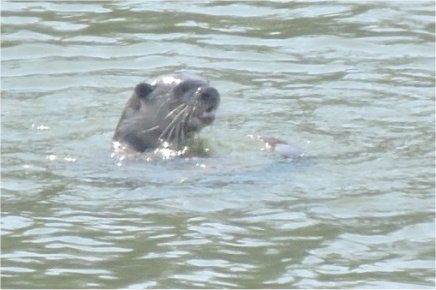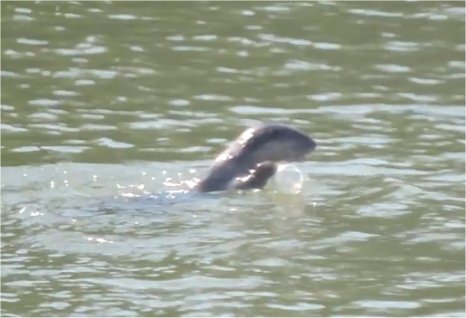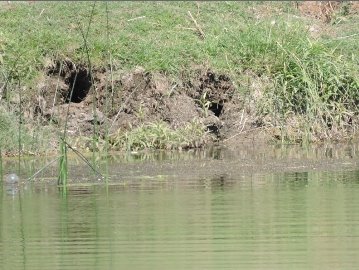IUCN/SSC Otter Specialist Group Bulletin

©IUCN/SCC Otter Specialist Group
Volume 34 Issue 2 (October 2017)
Citation: Suthar, AR, Rathod, JY, Patel, IB, Gavali, DJ and Lakhmapurkar, J (2017). Historical and Current Distribution of Smooth Coated Otter Lutrogale perspicillata in Gujarat, India. IUCN Otter Spec. Group Bull. 34 (2): 95 - 103
Historical and Current Distribution of Smooth Coated Otter Lutrogale perspicillata in Gujarat, India
Akshit R. Suthar1, Jagruti Y. Rathod1, Ishani B. Patel1, Deepa J. Gavali1 and Jayendra Lakhmapurkar1
1Gujarat Ecology Society, Synergy House, Subhanpura, Vadodara 390023, Gujarat, India





|
| (Received 18th March 2017, accepted 21th May 2017) |
| Download PDF (407 KB) |
| Abstract: Three species of otter are found in India, out of them only smooth coated otter Lutrogale perspicillata is reported in Gujarat. An extensive literature review was carried out to understand the historical distributions of species, to record current distribution and status; some potential sites and habitat were identified through detail survey. Available literature indicated presence of Otter in 11 different sites distributed in Central, south and north Gujarat. However, present distribution is restricted to Mahi, Narmada and Purna Rivers. Different direct and indirect observation methods including direct sighting, observing trails, tracks and burrows were applied. Survey along the Purna River indicated presence of burrows and direct sightings were reported. However in-depth study is required to ascertain the exact population of otter and threats to the species. Habitat fragmentation, lack of awareness and deficiency of baseline data on status, distribution and ecology of species is constraint of its conservation in Gujarat. Some long term monitoring, habitat restoration and awareness programs to involving relevant stakeholders should be initiated to ensure the survival of species in Gujarat. |
| Keywords: Smooth coated otter, Gujarat, Distribution, Conservation |
| Française | Español |
INTRODUCTION
Otters form a distinct group within the mammalian family Mustelidae and are grouped into sub-family Lutrinae (Sivasothi, 1995). Among the carnivores, they are only semi-aquatic group (Nowak, 1991). There are 7 genera and 13 species of otter worldwide, of which five are found in Asia. Three species –Lutrogale perspicillata (smooth-coated otter), Lutra lutra (Eurasian otter) and Aonyx cinereus (small-clawed otter) - are found in India (Reuther, 1991), and only Lutrogale perspicillata (smooth-coated otter) is reported in Gujarat.
The smooth-coated otter is widely distributed in South and South East Asia, including Pakistan, India, Nepal, Bhutan, Bangladesh, South West China, Myanmar, Thailand, Vietnam, Malaysia, Sumatra, Java and Borneo (Mason and Macdonald, 1986; Corbet and Hill, 1992).The Smooth-coated otter inhabits lakes, large rivers, dams, irrigation canals, swamps, shallow rice fields and coastal mangroves and prefers sloping banks with vegetation (Menon, 2003). Smooth-coated otters are indicators of the health of a wetland ecosystem because they are sensitive to environmental changes (Nawab, 2009). Ample bankside vegetation provides cover and escape and deep soil is needed for digging holes. Their prey includes mainly fish, supplemented by crabs, insects, mudskippers, frogs, birds and rats (IUCN Otter Specialist Group 2015).
Smooth coated otter is known to be one of the least studied species (Hussain and Chaudhry, 1997). It has been assessed as 'Vulnerable' by IUCN Red data book of Threatened species (IUCN, 2017) and listed in Appendix II of CITES (Shenoy, 2005). In India the species is protected and listed in Schedule II under the Wildlife Protection Act 1972.
Smooth coated otter is known as Jalbiladi, Ud-bilado, Jalmanus and Undu in local language in Gujarat. H.S. Singh (2013) has mentioned, survival of the species is doubted in the state and if they survive the numbers must be very low. However there is no any systematic work on status and distribution of otter carried out in Gujarat. The present study was aimed to document both historical as well as current distribution of the species in Gujarat.
STUDY AREA
Gujarat has varied climatic and geomorphologic conditions (Singh, 2001). Gujarat is very rich in floral and faunal diversity, due to diverse habitat in state such as, longest coastline of country; two out of three Gulfs are present here, plains, mangroves, saline desert, vast grassland, thorny and dry deciduous forest, coastal and inland wetlands. Five major rivers such as Mahi, Tapti, Narmada, Sabarmati and Banas are flows through state from north to south direction.
METHODOLOGY
An extensive literature review was carried out to explore the historic distribution of smooth-coated otter in Gujarat. Apart from gathering secondary information from published and unpublished literature and reports, relevant people in different areas, including the officials of Forest department, Fishermen folk, local villagers, researchers, Naturalists and wildlife photographers were contacted to obtain information about the historical distribution of otter in Gujarat. To gather primary information, all sighting sites were marked on the map, and visited all identified potential sites and habitat for otter. Once direct sighting or indirect evidences were found, GPS location, habitat types, terrain type, vegetation, condition of wetland and potential threats were noted down.
HISTORICAL DISTRIBUTION
Based on the available literature, secondary information and personal communication with local communities and some biologists, the historical distribution of smooth-coated otter in Gujarat was recorded and plotted on a map (Fig. 1). Past data of sighting shows that the species has scattered distribution in some rivers, ponds and dams of central, south and north Gujarat (Table 1). Broach Gazetteer (1961) mentioned the occurrence of otter in Narmada River and destruction of fish by otter in Tapti River of South Gujarat. Literature showed 9 records of sighting till 1998, after that no major sightings were reported. Small mammal survey in central Gujarat (GES 2007) confirmed the presence of species in state after almost a decade and half a dozen group of otter were direct seen in Mahi River. Singh (2013) mentioned that Mahi and Tapti Rivers supported good number of otters about 20 years ago. Thus, the past records indicated sporadic distribution of the species in various parts of the State.

|
| Figure 1. Map showing the historical and current distribution (up to Feb, 2017) of Smooth coated otter in Gujarat. (click for larger version) |
RESULTS
Smooth coated otter have been described in the past for Gujarat (Table 1).
| Table 1: Sightings of Smooth Coated Otter in Gujarat from literature review | |||||
| Sr.No | Place | Number | Year of Sighting | Remarks | Source |
| 1 | Vadnagar (Pond) | - | - | Singh (2013) is mentioned, this was based on information provided by villagers and could not be confirmed from other authentic source. | Singh (2013) |
| 2 | Lunawada (Mahi River) | - | - | Singh (2013) is mentioned, this was based on information provided by villagers and could not be confirmed from other authentic source. | Singh (2013) |
| 3 | Ukai Dam (Tapti River) | 1 | - | Singh (2013) is mentioned, fisherman encountered this animal in Ukai dam and dead animal was also found there. | Singh (2013) |
| 4 | Nava Talav (Pond) | - | 1966 | This was sighted by Mr. Malek at Nava Talav water tank near surendranagar. | Singh (2013) |
| 5 | Purna river | - | 1970 | A school teacher reported the species in Purna river in 1970, but the sighting place is not mentioned. | Singh (2013) |
| 6 | Navavas (Village Pond) | 2 | 1987 | Mr. M.K. Mahependrasinhji saw a pair of the species before drought in 1987. | Singh (2013) |
| 7 | Nikora (Narmada river) | 6 | 1987 | S.K. Sinha claimed that he saw a group of 6 individuals in Narmada river in 1987. | Sinha (1989) |
| 8 | Timba (Mahi River) | - | 1989 | Small population of species has been also reported by S.K. Sinha in Mahi river near Timba village. | Sinha (1989) |
| 9 | Little ran of Kutch (Banas River) | - | 1998 | During the mammals’ study of Gujarat in 1998, which was carried out by Nita shah, she reported that villagers had seen otters near fringe of Little Rann of Kutch in Banas river. | Singh (2013) |
| 10 | Lachhanpura (Mahi River) | 5 | 2007 | During survey of Small mammals in central Gujarat. GES team has reported 5 individuals of species in Mahi river near Lachhanpura village. They were playing in water and catching fishes. | GES (2009) |
| 11 | Tena Village Pond | 1 | 2011 | Otters used to live in the village pond, once woman who was busy in cloth washing was bitten by otter. In return the animal was killed by villagers. | Thakor (2015) |
Recent sightings
At three sites viz. Mahi, Narmada and Purna rivers of Gujarat, the Smooth coated otter were directly sighted (Fig. 1) (Table 2). March 2016, five otters were seen in resting activity near Garudeshwar of Narmada River by the first author. Seven otters, busy in fishing activity, have been sighted by first author on June 2016 at Amarapur Village of Mahi River. Two otters were sighted on February 2017 during survey of Purna River near Mahua village. Both were playing in water and out of them, one of the otter was photographed playing with plastic water bottle (Fig. 2). Three burrows of otters were also found near this site (Fig. 3)
DISCUSSION
A review of historical records, literature and personal communications with different biologists and naturalists of state revealed that, the isolated population of smooth-coated otter was found and scatteredly distributed in the Mahi, Tapti, Purna and Narmada rivers. Otters were also found at some nearby ponds and dams of these rivers and there is possibility of migration through tributaries and canals during flood time. Present study confirmed the existence of smooth coated otter in 3 rivers of Gujarat viz. Mahi, Purna and Narmada. Presence of three burrows at Purna indicated that, the species regularly used the stretch of river. Thus Purna is one of the prominent and promising sites for survival of otter in state.
The current study suggests that the otter population is facing a decline in Gujarat. The species, which had a scattered distribution in central, south and northern part of Gujarat, is now restricted in isolated population and in fragmented habitat at three sites. Habitat loss is the major reason for dwindling population of Smooth coated Otters and the trend of population decline is expected to continue (Hussain et al., 2008). Sand mining (Fig. 4), constructions along the riverside, water pollution, check dam and lack of awareness in local community are major threats identified during present study. These factors have compelled smooth-coated otter to live in scattered populations in fragmented habitats and roam around continuously for their survival.

|
| Figure 4. Sand mining activity nearby otter habitat at Purna River. (click for larger version) |
There is need for further extensive and intensive studies to exactly map out the distribution of otter in Gujarat and identify the threats as per the riverine system. There are also lacunae of studies on the use of habitat by Otter during different times of the year. Some questions like where, does the Otter move around during low water level in the rivers during the summers or heavy flow during the monsoons needs to be researched. Overall, deficiency of baseline data on Status, distribution and ecology of species is constraint for its conservation. If the threats and stresses it is facing persist, it will become endangered and its survival will be questioned in Gujarat. Hence, it is mandatory to conserve this species through restoration of its habitats, minimizing the threats, promote greater public awareness and involve local communities in the conservation.
Acknowledgements: Authors are grateful to Gujarat Ecology Commission for sponsoring the ecological profiling study, under which the present findings were reported. We are grateful to Mr. Rathod (DCF, Normal forestry Division -Surat) and Mr. Punit Nayar (DCF, Social forestry division-Surat) for their support to survey team. We are thankful to Sandeep Umaratkar, Alkesh Murli and Rahul Solanki for accompanying during field visits.
REFERENCES
Corbet, G.B., Hill, J.E. (1992). The mammals of the Indomalayan Region. A Systematic Review. Oxford University Press, U.K.
GES (2009). Occurrence, Distribution and status of Small and certain rare species of Mammals in central Gujarat. Sponsored by Gujarat Forest Department, 157 pp.
Hussain, S.A., De Silva, P.K., Feeroz, M. (2008). Lutrogale perspicillata. In: IUCN 2013. IUCN Red List of Threatened Species. Version 2013.2.
Hussain, S.A., Choudhury, B.C. (1997). Status and distribution of Smooth-coated Otter Lutrogale perspicillata in National Chambal Sanctuary. Biol. Cons. 80: 199-206.
IUCN Otter Specialist Group (2015). Smooth-Coated Otter. [Available from http://www.otterspecialistgroup.org/Species/Lutrogale_perspicillata.html]
Mason, C.F., Macdonald, S.M. (1986). Otters: ecology and conservation. Cambridge University Press, Cambridge, London.
Menon, V. (2003). A Field Guide to Indian Mammals. Dorling Kindersley, India.
Nawab, A. (2009). Aspects of the ecology of Smooth-coated Otter Lutrogale perspicillata. Geoffroy St. Hilaire, 1826: A Review. Journal of Bombay Natural History Society, 106, 5-10.
Nowak, R.M. (1991). Walker's mammals of the world. Fifth edition. John Hopkins University Press, Baltimore and London.
Palande, MR et al (1961). Gujarat State Gazetteers: Broach District. Government of Gujarat
Reuther, C. (1991). Otters in captivity – review with special reference to Lutra lutra. Habitat, 6, 269-307.
Shenoy, K. (2005).Otters in the River Cauvery, Karnataka. Wildlife Trust of India.
Singh, H.S. (2001). Natural Heritage of Gujarat. GEER Foundation, Gandhinagar.
Singh, H.S. (2013). Mammals in Gujarat. Gujarat Biodiversity Board, Gandhinagar and Gujarat Forest Department, Gandhinagar. 219 pp.
Sinha, S.K. (1989). Colorful wildlife of Gujarat. Gujarat Forest Department.
Sivasothi, N. (1995). The status of Otters in Singapore and Malaysia, and the diet of Smooth coated Otter Lutrogale perspicillata in Penang, West Malaysia. M. Sc. Thesis, National University of Singapore, Singapore.
Thakor, P. (2015). Tena village wetland, Surat district, Gujarat, India. Jalaplavit. 6: 44-53.
Résumé: Distribution Passée et Actuelle de la Loutre à Pelage Lisse Lutrogale Perspicillata au Gujarat en Inde
Trois espèces de loutre sont présentes en Inde, et parmi elles, seule la loutre à pelage lisse Lutrogale perspicillata est recensée au Gujarat. Une recherche étendue de la littérature scientifique a été réalisée afin de comprendre la distribution historique de l’espèce, tout cela pour enregistrer leur distribution et statut actuel ; quelques sites et habitats potentiels ont été identifiés via des surveillances détaillées. La littérature disponible indiquait la présence de loutre à 11 différents sites distribués dans l le centre, le sud et le nord du Gujarat. Cependant, leur distribution actuelle est restreinte aux rivières Mahi, Narmada et Purna. Différentes méthodes directes et indirectes d’observation, incluant les observations directes, l’observation de sentiers, pistes, et terriers furent utilisées. La surveillance le long de la rivière Purna permit de relever la présence de terrier ainsi que de rapporter des observations directes. Cependant une étude plus approfondie est requise pour établir la population exacte de loutre ainsi que les menaces envers cette espèce. La fragmentation de l’habitat, le manque de sensibilisation et l’insuffisance de données sur la population initiale, sa distribution, son écologie des espèces présentes sont des contraintes vis-à-vis de sa conservation au Gujarat. Quelques suivis sur le long terme. Restauration d’habitats et programme de sensibilisation pour impliquer les parties prenantes concernées devraient être initiées pour assurer la survie de cette espèce au Gujarat.
Revenez au dessus
Resumen: Distribución Histórica y Actual de la Nutria Lisa Lutrogale Perspicillata en Gujarat, India
En India se encuentran tres especies de nutria; de ellas, sólo la nutria lista Lutrogale perspicillata está reportada para Gujarat. Llevamos a cabo una extensiva revisión de bibliografía para comprender la distribución histórica de esta especie; para registrar su actual distribución y status de conservación identificamos algunos sitios y hábitats potenciales mediante un relevamiento detallado. La bibliografía disponible indicaba la presencia de la nutria en 11 sitios distribuidos en Gujarat central, sur y norte. Sin embargo, la presencia actual está restringida a los Ríos Mahi, Narmada y Purna. Aplicamos diferentes métodos de observación directos e indirectos, incluyendo avistajes, observación de senderos, huellas y madrigueras. El relevamiento a lo largo del río Purna indicó la presencia de madrigueras, y se informaron avistajes directos. Sin embargo, se requiere un estudio en profundidad para evaluar la población exacta de nutrias y las amenazas a la especie. Factores como la fragmentación del hábitat, la falta de conciencia, y la deficiencia de los datos de base acerca del status, distribución y ecología de la especie, limitan y afectan su conservación en Gujarat. Deberían iniciarse programas de monitoreo de largo plazo, restauración de hábitats y concientización para involucrar a los actores relevantes, para asegurar la supervivencia de la especie en Gujarat
Vuelva a la tapa


